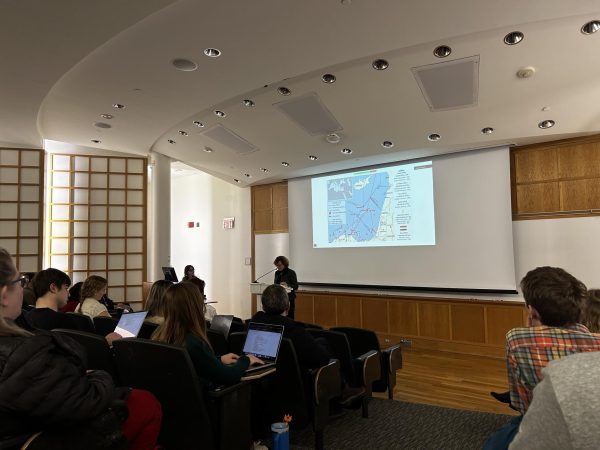Colgate’s Very Own Dada Movement
“SEX! DRUGS! SCANDAL!” This was the subject line of a campus-wide e-mail that was sent to all Colgate students last week from a mysterious entity calling itself DADA. In the week preceding the e-mail, strange flyers appeared at many bulletin boards across campus advertising DADA with odd sayings such as, “DADA is the reason why you came closer to read this,” “DADA does not like to be torn down” and simply “DADA is.”
Assistant Professor of English Amy Feinstein explained the Dadaism cultural movement of Europe, which began in response to World War I.
“[Dada] was aimed at a society which held up high culture and was at the same time killing each other,” Feinstein said. “[Dada] tried to point out the hypocrisy of slaughter in a society that was supposed to celebrate life.”
Dada, as a movement in literature and art, can be described as absurdist; it was intentionally not straightforward or lasting. It was essentially a series of public art forms that didn’t make sense, which would explain the unusual e-mail.
“It’s art that’s designed to cause a stir,” Feinstein said. She mentioned that Dadaists often used humor and dramatic language combined with the absurd to get their message across. The following excerpt from the e-mail shows this technique.
“Last week, DADA, arising after 80 years of peacefully rotting in the indigestible cum of surrealist necrophilia, found an appropriate forum for expression on walls filled with other meaningful advertisements,” the e-mail said. “Many of you found it necessary to tear DADA down. This excites DADA, as it proves that men continue to be offended by things that are incomprehensible.”
Students reacted to the flyers and also to the mass e-mail, which contained shocking and strange phrases.
“I think they were just being peculiar for the sake of being peculiar,” first-year Zoey Baldwin said. “I feel like the point was to confuse people, to get their attention.”
“I think they did a good job of getting themselves noticed on campus,” first-year Sean O’Hanlan said. “I don’t think they’re failing or succeeding because I don’t think they’re trying to get people to understand anything. I just wish I knew who was doing it.”
Feinstein feels that the e-mail, which began, “Greetings Apathetic Colgate Community!” was supposed to be a calling into question of the social norms of student life at Colgate, to have students question themselves in the same way the original Dadaists wanted their culture to question itself.
“[The e-mail is] a call to wake up,” she said. “It plays to some of the stereotypes of Colgate students and criticizes the actions behind those stereotypes.”
She referred to a pejorative phrase in the DADA e-mail, “to put it in terms you will easily understand: DADA, like cheap alcohol, is the answer.”
“The shock value of these phrases is meant to be an artistic jolt to the system.” Feinstein said. “This Colgate DADA is trying to loosen things up a little.” She said that the capitalization of “DADA” in the Colgate movement in and of itself is meant to capture attention, which she says was the point of the subject line, “SEX! DRUGS! SCANDAL!” in the DADA e-mail.
Dadaism as a cultural movement also fought against intellectual conformity, which was addressed in the e-mail.
“Fortunately for you sterile prostitutes of progress, men of centuries past have agonized themselves over the problem of incomprehensibility, and found a solution through a reduction of the world to a series of questions – who, what, where, when, why, and how. So long as these questions could be answered and transformed into axiomatic fragments of intellectual diarrhea, men no longer needed to feel insulted by the meaningless world they inhabited. DADA finds such serious pursuance of intellectual excrement disgusting.”
Feinstein explained that the original Dada movement was designed to be temporary, and that the art was made not to last, but was designed to always keep current and new.
“The best way to learn about Dada is to experience it in this way.”
Feinstein said, referring to the hands-on experience that students are having with this movement. “Dada is about this moment, not the past.”
Feinstein speculates that students who are involved with the
Department of Art and Art History may be behind the DADA movement at Colgate. She said it may be some students’ final projects because of the time in the semester in which the flyers first started appearing and the fact that Art History concentrators handed in their theses last week.
Recently, new flyers regarding Vorticism have been spotted around campus. Vorticism was a British art movement that preceded Dada and was similarly absurdist. It is likely, Feinstein believes, that the movements on campus are closely related. With these recent flyers, it is unclear whether the DADA movement on campus is over or whether students will be subject to even more strange events as the semester comes to a close.





